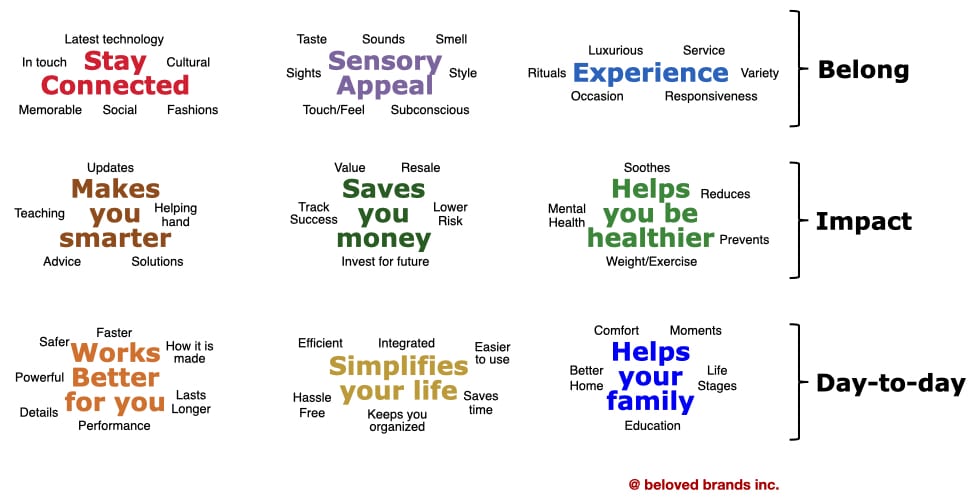Maslow’s hierarchy of needs provides a smart logic and focus on understanding consumer needs. The best marketers gain comfort in exploring the psychology models to help with how consumers see the world, whether borrowing Carl Jung’s archetypes to help define a brand’s personality or Maslow’s hierarchy of needs to tap into the mindset of consumers.
As famous as Maslow’s hierarchy of needs, there is very little scientific basis to the idea. That’s ok. We are only borrowing the concept, not psychoanalyzing an individual. In theory, Maslow used the terms “physiological”, “safety”, “belonging and love”, “social needs,” or “esteem,” and “self-actualization.”
Maslow's hierarchy
The basic thoughts for marketers are that consumers will focus on their basic needs before they can reach for things like esteem or self-actualization. During the coronavirus pandemic, we can even see how we return to our basic needs of food, shelter, safety, even ahead of status or money or using fashion as an expression.
Going beyond Maslow's Hierarchy
As a brand leader, you can learn from the basics of Maslow’s Hierarchy, but let’s twist it into something workable for you. Above, you can see how I have turned Maslow’s Hierarchy zones into three functional need types, including the day-to-day needs, impact on your life, and belonging. And, this leads into three emotional need types, including trust, expression, and realization.
Take your brand knowledge to new heights with our Beloved Brands playbook
Beloved Brands is a comprehensive guide that covers the fundamentals of brand management. It goes deep on strategic thinking, brand positioning, brand plan development, advertising decisions, media planning, marketing analytics, and the brand financials. This is an opportunity to build your marketing skills to help your career. And, it will provide you with the roadmap for driving growth on your brand.

Marketers see Beloved Brands playbook as a go-to resource, as they keep it within arm’s reach for any new project. We are thrilled to see that it has received a 5-star rating from nearly 90% of Amazon reviewers. Additionally, we have also created playbooks for B2B Brands and Healthcare Brands, catering to specific industries.
Consumer benefits
Transforming Maslow’s hierarchy into functional needs
To start, let’s discuss the functional needs of your consumers:
- First, the day-to-day needs include “works better for you,” “simplifies your life,” and “helps your family.”
- Second, the life impact needs include “getting smarter,” “saving you money,” and “health.”
- Third, the belonging needs include “staying connected,” “sensory appeal,” the “experience you get.”
Below, we have expanded on each of these functional consumer needs to help you begin thinking about your brand positioning. Look for the ideal functional benefits to differentiate your brand from competitors.
Functional consumer needs
Now, let’s look at the consumers’ emotional needs from the vantage of Maslow’s hierarchy:
- First, the trust needs include “how to stay in control,” “feel myself,” and “self-assured.”
- Next, you move up to the expression needs that include “feel free,” “get noticed,” and “feel liked.”
- Finally, move up to the realization needs, including the “curiosity for knowledge,” “sense of optimism,” and “feel comfortable.”
Below, you can find an expanded list of emotional consumer needs to focus on your brand positioning. Use these ideal emotional benefits to differentiate your brand from competitors.
Emotional consumer needs
Brand Positioning video lesson
Our brand positioning statement video shows how to use our functional benefit cheatsheet and our emotional benefit cheatsheet to help build the ideal brand positioning statement.
To view, use the ▶️ controls to play or volume buttons
Consumers have changed
It takes a smart strategy to balance the rational and emotional management of the brand-to-consumer relationship. These beloved brands are so exceptional because of how well they treat their most loyal consumers. They make them feel loved.
The consumers of today must be won over. They are surrounded by the clutter of 5,000 brand messages a day that fight for a glimpse of their attention. That is 1.8 million per year or one message every 11 waking seconds.
Consumers are continuously distracted—walking, talking, texting, searching, watching, replying—and all at the same time. They glance past most brand messages all day long. Their brain quickly rejects boring, irrelevant, or unnecessary messages. Brands must capture the consumer’s imagination right away, with a brand idea that is simple, unique. It must create as much excitement as a first-time encounter.
Consumers are tired of being burned by broken brand promises. Once lied to, their well-guarded instincts begin to doubt first, test second, and at any point, they will cast aside any brand that does not live up to the original promise that captured them on the first encounter. A brand must be worthy of love. The best brands of today have a soul that exists deep within the culture of the brand organization.
Brands must be consumer focused
The brand’s purpose must be able to explain why the people who work behind the scenes of the brand come to work every day so energized and ready to over-deliver on the brand’s behalf. This purpose becomes a firm conviction, with inner motivations, beliefs, and values that influences and inspires every employee to want to be part of the brand. This brand conviction must be so firm that the brand would never make a choice that directly contradicts their internal belief system. Consumers start to see, understand, and appreciate the level of conviction with the brand.
Brands must listen, observe, and start to know their consumer’s thoughts before they even think them. Not only does the brand meet their functional needs, but the brand must also heroically beat down the consumer’s enemy that torments their life every day.
Borrowing from Maslow's Hierarchy of needs will help you organize your thinking on our consumers' needs.
Beloved Brands video
Everything a Marketing must know about.
Importantly, Brand leaders need to know how to think, define, plan, execute and analyze with the best of them. Moreover, while the brand leaders don’t really know how to do anything, they are looked upon to make every decision. Have a look at our five minute video on everything a marketer must know. To read more, click on this link: Everything.
To view, use the ▶️ controls to play or volume buttons
If you are looking to make your marketing team smarter, we can help. To get started, email Graham Robertson at [email protected]










